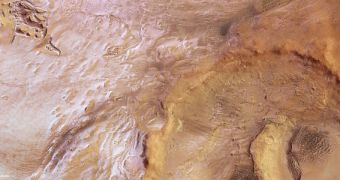The European Space Agency's (ESA) Mars Express spacecraft captured a series of new images of the second-largest asteroid impact basin on the surface of Mars, called Argyre. The orbiter was even able to produce an anaglyph 3D photograph of the landscape feature.
Astronomers collected the data using the High-Resolution Stereo Camera (HRSC) instrument on the spacecraft. The basin itself is around 1,800 kilometers (about 1,120 miles) wide, and about 5 kilometers (3 miles) deep.
The asteroid that produced it must have been massive, experts agree. “The name stems from the Greek word ‘argyros’ (silver) and Argyre was an ‘island of silver’ in Greek and Roman mythology,” ESA experts stay in a press release.
The “icing sugar-like covering of the surface to the south (left) of the image” is snow. However, the material is not made up of frozen water, like on Earth, but out of extremely cold carbon dioxide.

 14 DAY TRIAL //
14 DAY TRIAL //